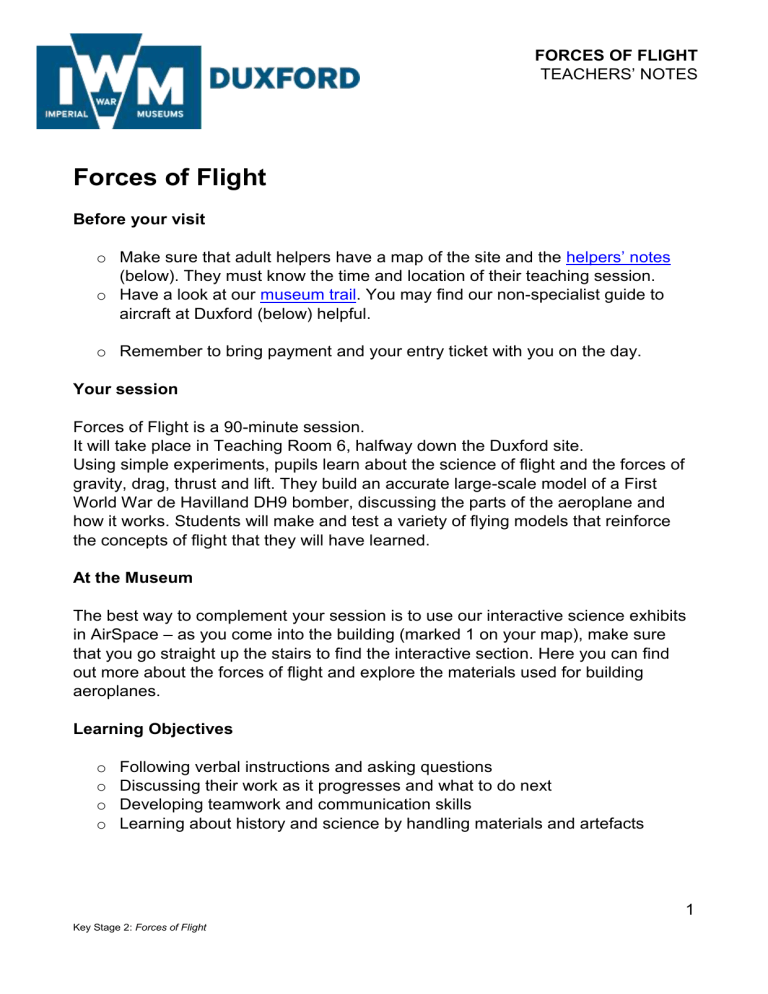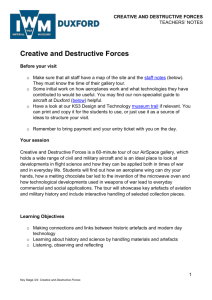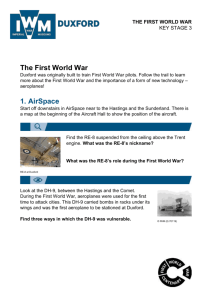Teachers' Notes - Imperial War Museum

FORCES OF FLIGHT
TEACHERS’ NOTES
Forces of Flight
Before your visit o
Make sure that adult helpers have a map of the site and the helpers’ notes
(below). They must know the time and location of their teaching session. o Have a look at our museum trail . You may find our non-specialist guide to aircraft at Duxford (below) helpful. o Remember to bring payment and your entry ticket with you on the day.
Your session
Forces of Flight is a 90-minute session.
It will take place in Teaching Room 6, halfway down the Duxford site.
Using simple experiments, pupils learn about the science of flight and the forces of gravity, drag, thrust and lift. They build an accurate large-scale model of a First
World War de Havilland DH9 bomber, discussing the parts of the aeroplane and how it works. Students will make and test a variety of flying models that reinforce the concepts of flight that they will have learned.
At the Museum
The best way to complement your session is to use our interactive science exhibits in AirSpace – as you come into the building (marked 1 on your map), make sure that you go straight up the stairs to find the interactive section. Here you can find out more about the forces of flight and explore the materials used for building aeroplanes.
Learning Objectives o Following verbal instructions and asking questions o Discussing their work as it progresses and what to do next o Developing teamwork and communication skills o Learning about history and science by handling materials and artefacts
1
Key Stage 2: Forces of Flight
Forces of Flight : Adult helpers’ notes
Your visit
Check that you have a map of the site and know the times and locations of your booked activity and lunch.
FORCES OF
FLIGHT
Time:
Lunch
Time:
Location: Teaching Room 6 (building 72)
Walk down the site and turn right at the control tower (pictured).
Keep walking until you pass Wing Co Joe’s café.
Teaching Room 6 is just beyond the back of the café, on your right. A member of museum staff will meet you at the door to your location at your session time.
Location: Eating Space (or outside if the weather is nice)
Your session
Forces of Flight is a 90-minute session.
It will take place in Teaching Room 6, halfway down the Duxford site.
Using simple experiments, pupils learn about the science of flight and the forces of gravity, drag, thrust and lift. They build an accurate large-scale model of a First
World War de Havilland DH9 bomber, discussing the parts of the aeroplane and how it works. Students will make and test a variety of flying models that reinforce the concepts of flight that they will have learned.
At the Museum
The best way to complement your session is to use our interactive science exhibits in AirSpace – as you come into the building (marked 1 on your map), make sure that you go straight up the stairs to find the interactive section. Here you can find out more about the forces of flight and explore the materials used for building aeroplanes.
2
Key Stage 2: Forces of Flight
Non-Specialist Guide to Aircraft at IWM Duxford
This guide is to help you to answer some of the basic questions you and your children might have about the aircraft you will see at IWM Duxford.
Types of Aircraft
All aeroplanes are aircraft but not all aircraft are aeroplanes. An aircraft is any craft that travels in the air, including balloons and airships as well as aeroplanes, helicopters and missiles. Aircraft can be divided into two main categories: heavierthan-air craft and lighter-than-air craft.
Lighter-than-air craft float in the air. Hot air balloons, gas filled balloons and gas filled airships are the main examples of lighter-than-air craft. There are no complete examples of such aircraft at IWM Duxford, but you can see the gondola of Richard
Branson’s hot air balloon in AirSpace and there is a packed Second World War barrage balloon in Hangar 4.
Heavier-than-air craft can be rotary wing or fixed wing. o Rotary wing helicopters (from the Greek helix – spiral and pteron – wing) have a set of blades which act like wings but also rotate to allow the aircraft to lift vertically. o Fixed wing aeroplanes have wings that do not move, although aeroplanes such as the F-111E in the American Air Museum have “swing wings” which allow the pilot to change the wing shape.
Parts of an aeroplane o The fuselage (from a French word for spindle) is the long main section of the aeroplane. Apart from supporting everything else, it is the load carrying part for the passengers, cargo or weapons and of course the pilot. o The wing or mainplane is attached to the fuselage in two symmetrical halves.
Technically a monoplane has only one wing and a biplane two, although most people will talk about an aeroplane’s “wings”. The wing provides upward force or lift, while ailerons (moveable surfaces) on the wing are used to control side-toside movement or “roll”. o The tailplane or horizontal stabiliser is like a small wing at the back of the plane. The elevators (more moveable surfaces) on the tailplane allow the pilot to control the up and down movement or “pitch” of the aeroplane. o The tailfin or vertical stabiliser sticks up vertically from the tail of the aeroplane. The rudder on the fin allows the pilot to control the left and right movement or “yaw”. o The undercarriage supports the aeroplane when it is on the ground and usually has wheels and springs attached.
3
Key Stage 2: Forces of Flight
Aeroplane Engines
The engine provides thrust to push the aeroplane forward, which in turn provides lift from the wing. You will see two main types of engine at Duxford: piston engines with airscrew propellers and gas turbines with jet propellers.
A piston engine is similar to that used in most road vehicles, but in an aeroplane it drives the airscrew. An airscrew is the set of twisted blades which push the air back as it spins, thrusting the aeroplane forward.
A gas turbine engine is a tube through which air is forced to create thrust. The air is sucked in at the front, squeezed into a small space, mixed with fuel and ignited to make it expand and blown out of the narrow jet pipe at the rear.
At IWM Duxford there are some aeroplanes such as the Britannia with gas turbines which drive airscrew propellers. These are usually called “turboprops”.
Types of aeroplane
At IWM Duxford the biggest collection is of military aircraft which fall into several main categories including fighter, bomber, reconnaissance and transport. o Fighters are small, fast and highly manoeuvrable. They usually have forward facing guns, often set within the wing. Most of the aeroplanes in Hangar 2 are fighters. o Bombers are usually large, with space in the fuselage to carry the bombs which are dropped from beneath through bomb doors. Many bombers such as the Lancaster in AirSpace have gun turrets for defence against fighters. o Reconnaissance aircraft are usually small with facilities for observers, cameras etc. They were often modified fighters although many have been purpose built, such as the SR71 “Blackbird” in the American Air Museum. o Transport aircraft are used to carry troops and supplies. The Hastings in
AirSpace is a good example. o Multi-role aircraft such as the F-111 perform two or more of the roles above and are more common in modern air forces.
IWM Duxford also has an extensive collection of commercial aircraft ranging from early airliners such as the Dragon Rapide to the first jet airliner, the Comet, and
Concorde, the only supersonic airliner in commercial service.
4
Key Stage 2: Forces of Flight






